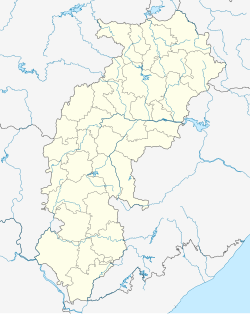Manendragarh
| Manendragarh | |
|---|---|
| Municipal Town | |
| Location in Chhattisgarh, India | |
| Coordinates: 23°11′32″N 82°12′01″E / 23.1922°N 82.2003°ECoordinates: 23°11′32″N 82°12′01″E / 23.1922°N 82.2003°E | |
| Country |
|
| State | Chhattisgarh |
| District | Koriya |
| Government | |
| • MP | Dr. Banshi Lal Mehto (Bharatiya Janata Party) |
| • MLA | Mr. Shyam Bihari Jaiswal (Bharatiya Janata Party) |
| • Municipal Chairman | Rajkumar Kesharwani(CONGRESS) |
| Area | |
| • Total | 10 km2 (4 sq mi) |
| Population (2011) | |
| • Total | 33,071 |
| • Density | 3,300/km2 (8,600/sq mi) |
| Languages | |
| • Official | |
| Time zone | IST (UTC+5:30) |
| PIN | 497442 |
| Telephone code | +91 7771 |
| Vehicle registration | CG-16 |
Manendragarh is a town of the Koriya district that is a part of the state of Chhattisgarh. The city housing the taluk headquarters along with few important district head offices is sited near the Chhattishgarh -Madhya Pradesh state border.
The nearest airport is at Raipur in Chhattisgarh. Manendragarh Railway Station is on the Anuppur-Chirmiri rail route. There are many coal mines around here. Manendragarh was originated by some tribals around 100 years ago; later developed by British Raj for coal excavation. Road and Railway Lines are developed by the British.
National Highway 43 has its route through Manendragarh. Amrit Dhara Waterfall is a nearby attraction. "Sidh-Baba" mount is famous for the Lord Shiva temple..
As of the 2011 India census, Manendragarh had a population of 30,748. Males constitute 53% of the population and females 47%. Manendragarh has an average literacy rate of 72%, higher than the national average of 59.5%: male literacy is 79%, and female literacy is 64%. In Manendragarh, 13% of the population is under 6 years of age. Manendragarh is the hub of rural items.
Region of Manendragarh has vast reserves of high-grade coal. The main coal belts are in the Hasdo basin. There are small deposits of limestone, fire clay and red oxide in Manendragarh.
A part of Manendragarh region lies in the Ganges basin and the remaining portion is in the Mahanadi basin. Gopad is the major tribute of Son and originates about 10 miles North of Mendra village. It drains the Northern portion of the District. Hasdeo a major tributary of Mahanadi has its origin in Mendra village.
Manendragarh has vast range of forests. Up to the last decade of the 19th century, Korea
Most common trees of Korea District are Sal, Mahua, Tendu, Palas, Char, Bija, Harra, Bahera, Sisam, Kusum, Salya, Khair, Arun, Gamhar etc. Bamboos are mostly available in the forests.
The Hasdeo river is the largest river flowing towards the South. It rises from 23°30´ North by 82°30´ East on the Sonhat Plateau and drains the South-Western part of the District. In this District, the river course resembles an upturned 'S' and flows for about 95 km. After a course of about 72 km, it enters Bilaspur District at 23° North. It receives the waters of the Gej and the Chornai on the left bank and the Tan and the Ahiran on the right before it meets the Mahanadi. The total length of the river is 245 km. The valley is narrow. Important settlements along the river are Sonhat, Ghugra, Manendragarh, Kosgain, Korba and Champa.
...
Wikipedia


